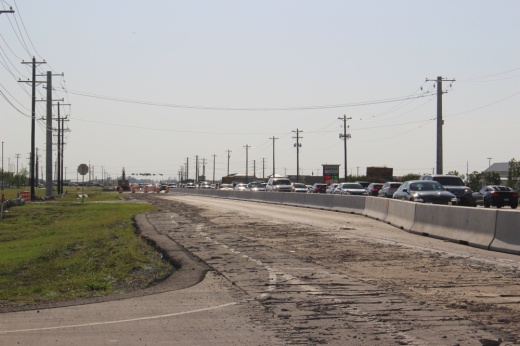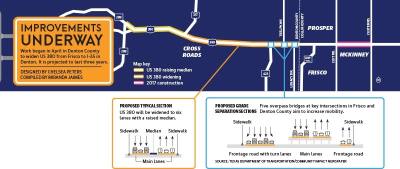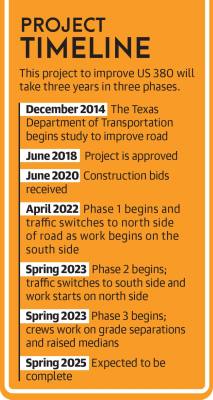Work began in April to relieve congestion that commonly occurs along 15 miles in Denton County. Officials expect that US 380 congestion near the upcoming Professional Golfers’ Association of America headquarters will nearly triple by 2045.
US 380 is a major east-west corridor in the county, McKinney Mayor George Fuller said.
“It is necessary for regional mobility, and we should always look at it as such, never as an individual community or city,” he said.
With the construction of major developments, including the West Grove mixed-use development in McKinney and the PGA Frisco headquarters along the US 380 corridor, officials say expanding the roadway is imperative when combined with explosive population growth.
Collin County Commissioner Darrell Hale, whose precinct includes McKinney, said US 380 is a huge connector for McKinney residents and other area drivers to travel east and west through Collin and Denton counties.
“We have no other east-west highway that is untolled,” Hale said. “Some kind of capacity improvement for US 380 is definitely needed.”
The $140 million Texas Department of Transportation project includes widening US 380 from US 377 to just west of the Collin County Line in Frisco. Five bridges will also be constructed at key intersections along the corridor.
Work also began last year on a $20.6 million project to add a raised median with left- and right-turn lanes from Loop 288 to the US 377 and US 380 intersection in Denton.
Both segments of work are expected to be complete in 2025, officials said.
Denton County Commissioner Ryan Williams, whose precinct includes Frisco, said improving US 380 has “been long overdue.”
“We have experienced an amazing amount of growth along [US] 380, and more is coming. Widening [US] 380 first and foremost makes this a safer highway and will undoubtedly save lives,” he said. “Beyond that, it will save our residents a lot of valuable time getting to and from work and play.”
A ‘critical’ corridor
Out of more than 1,800 roadways measured in Texas, a 2021 study from the Texas A&M Transportation Institute ranked US 380 from US 377 to the Dallas North Tollway as the 43rd most congested roadway in the state.
US 380 carries about 46,000 cars a day, per TxDOT data. This is almost as much as I-35W in Denton, which experiences about 48,000 cars a day.
Officials said the road is used to help people across the region get to and from work as well as access businesses and services.
“People are coming to Collin County to work and then leaving and going home into other counties,” Hale said.
Hale said he has spent years hearing people have “near continuous” discussions about the problems on US 380.
And traffic is expected to increase. The new PGA headquarters in Frisco is opening later this year and will be located off US 380, west of the Dallas North Tollway. The first tournament will be held next year, and the Frisco Senior PGA championship will be held in 2027, Frisco Mayor Jeff Cheney said.
“We’re going to need the ability to move hundreds and thousands of people ... to host these types of events,” Cheney said. “[US] 380 and that infrastructure being complete is a critical component.”
A McKinney project coming to US 380 and Custer Road is West Grove, a 52-acre, 600,000-square-foot retail, dining, office, residential and entertainment mixed-use destination.
The area overall is also increasing in population. Between 2010 and 2020, Denton County grew more than 36%, according to data from the U.S. Census Bureau. Collin County’s population is expanding even faster, growing almost 42% in that same time frame.
TxDOT studies show the population in the area of US 380 from I-35 to the Collin County Line has grown 92% from 2010-20 and is expected to continue to rise at a rapid pace, contributing to the need to enhance US 380 at the Collin County line.
Work being done
Crews are working to build an additional travel lane in each direction from US 377 to the county line, add a raised median to reduce crossover accidents and also build five grade-separated interchanges. These will be constructed at Navo Road, FM 720, FM 423, Teel Parkway and Legacy Parkway.
“[The interchanges create] a ‘super street’ that is the next classification of roadway below a freeway,” Williams said.
Construction will be divided into three phases, with each phase set to last about a year, TxDOT Public Information Officer Kendall Kirkham Sloan said.
In the first phase that began April 20, traffic switched to the north side of US 380 as crews work on the south side of the road. In the second phase this will alternate, with traffic on the south side. The final phase will consist of grade separations and construction of the raised median, Sloan said.
“Each phase will focus on working on the entire span of the project at once,” Sloan said in an email. “Intermittent lane closures and reductions of lanes on the cross streets can be expected, but there will be no long-term reduction to the number of lanes of US 380 during construction.”
Connection to Collin County plans
There are several projects planned to relieve traffic on US 380. While the US 380 construction in Denton County widens the road into Frisco, future plans are in place to create a freeway bypass through Collin County. The bypass would start at US 380 on the west side of the city and travel north of the roadway up to US 75 before heading back southward to connect with US 380 again. Another project in Collin County, the Outer Loop, is proposed to extend east from the Denton County and Collin County line, then south to Rockwall County.
One of the main problems with US 380 is that it was constructed to function as a high-speed rural road, Sloan said. But that is no longer how the roadway is being used.
“This reconstruction will update the roadway to operate as an urban section that will better serve how US 380 is being used today,” Sloan said in her email.
Similar work to upgrade US 380 in Collin County from a rural roadway to an urban one was completed in 2017 between Coit Road and Custer Road, TxDOT Public Information Officer Madison Schein said. The improvement project in Denton County will match the improvements that were made on the Collin County side of the road, while also tying into future projects, such as the Collin County bypass around US 380.
At an April meeting, McKinney City Council passed a resolution that favored an alignment for the bypass that travels into the city of Prosper. However, Prosper officials favor a different alignment that travels into McKinney. Meanwhile, Collin County commissioners passed a resolution saying the existing alignment for US 380 is best.
TxDOT is scheduled to identify a preferred US 380 bypass alternative and further develop its schematic design by the end of the year. This will be presented at a public hearing in early 2023.
The road ahead
There is more that needs to be done to relieve congestion on US 380, Hale said. This includes the county’s Outer Loop. Denton County commissioners have begun the preliminary phase on the Outer Loop project from I-35 to the Denton County/Collin County line, Williams said.
In addition, Collin County is finishing a north-south highway study on the east side of the county, which examines whether Collin County needs one or two northbound highways in that area.
“It’s all tied in together with [US] 380 being the first domino to fall,” Hale said.At the meeting, TxDOT officials said projections show that by 2045, if no additional improvements are made to the US 380 study area beyond the in-progress project, congestion is expected to increase more than 200%. That is three times what was experienced in 2020, the presentation stated.
Cheney said he expects the bridges in the ongoing project to “significantly” help traffic flow not only in Frisco, but also surrounding cities.
Fuller said no matter what happens with US 380, it needs to be viewed holistically since it is a crucial corridor for the region.
“That is why it is a state road,” he said.







